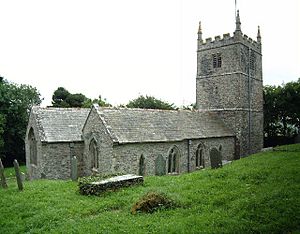St Julitta's Church, St Juliot facts for kids
Quick facts for kids St Julitta’s Church, St Juliot |
|
|---|---|

St Julitta’s Church, St Juliot
|
|
| 50°41′34.51″N 4°39′11.7″W / 50.6929194°N 4.653250°W | |
| Location | St Juliot |
| Country | England |
| Denomination | Church of England |
| Churchmanship | Broad church |
| History | |
| Dedication | St Julitta |
| Architecture | |
| Designated | 17 December 1962 |
| Administration | |
| Parish | St Juliot (Boscastle and Tintagel Group of Churches) |
| Deanery | Stratton |
| Archdeaconry | Bodmin |
| Diocese | Diocese of Truro |
| Province | Province of Canterbury |
St Julitta's Church, St Juliot is a very old church located in St Juliot, a small village in Cornwall, England. It's a special kind of church called a parish church and belongs to the Church of England. This church is dedicated to Saint Julitta, a local saint from Cornwall. It's also listed as a Grade II* listed building, which means it's an important historical building that needs to be protected. Another church, St Julitta's Church, Lanteglos-by-Camelford, is also named after the same saint.
Contents
History of St Julitta's Church
The church is named after Saint Julitta. It stands in a quiet spot above the River Valency valley. Other churches in the area, like the one in Lanteglos by Camelford and a chapel at Tintagel, are also dedicated to Saint Julitta. The church is part of the St Juliot area in northeast Cornwall.
Early Beginnings and Changes
The church building is even older than the Domesday Book, which was a big survey done in England in 1086. The original church, built in the Dark Ages, was made bigger in the 13th century. During this time, transepts were added. Transepts are parts of a church that stick out on the sides, making the building look like a cross.
In 1238, the chapel of St Julitta became part of the Launceston church group. Before 1269, it was connected to their church of St Gennys. Later, in the late 15th century, a south aisle and a porch were added to the church. An aisle is a passage along the side of a church.
Changes Over Time
During the Reformation, a big change in the church in England, St Julitta's Church became separate from St Gennys. It became a "donative," which meant it was given to a priest called a "perpetual curate" who was paid a yearly amount. In 1865, it became a rectory, which is a church led by a rector. There used to be a north transept, but it was removed during the Victorian restoration, which was a time when many old churches were repaired or rebuilt.
Church Features and Art
The church tower has three levels. The south aisle is built from granite. It also has an extra section that goes past the end of the main part of the church. Inside, you can see a special vaulted granite south porch. There's also a bronze artwork showing the Deposition of Christ, which means Jesus being taken down from the cross. This artwork was made by an Italian artist in the 16th-century who followed a style called Mannerism.
Cornish Crosses and Parish Group
There are two ancient Cornish crosses in the churchyard. One of these crosses was originally located at Anderton Mill, but it was moved to the churchyard in 1852 to keep it safe. Today, St Julitta's Church is part of a group of Anglican churches in the Boscastle area.
Restoration by Thomas Hardy
The church was looked at by an architect named John Hicks in 1867. However, he passed away before he could start the restoration work. The church was then restored between 1870 and 1872 by Thomas Hardy. This restoration was almost like rebuilding the entire church. Some people thought that more of the original building could have been saved instead of being replaced. The church officially reopened on April 25, 1872.
Thomas Hardy is famous not just as an architect, but even more so as a poet and novelist. He met his wife at St Julitta's Church in 1870. He later wrote a novel called A Pair of Blue Eyes and some poems in 1912–13, which were inspired by his time in this parish.
Parish Grouping
St Julitta's Church is part of the Boscastle and Tintagel group of parishes. This means it works together with several other local churches.
- St Symphorian's Church, Forrabury
- St Merteriana's Church, Minster
- St Michael and All Angels' Church, Lesnewth
- St Denis' Church, Otterham
- St Materiana's Church, Tintagel
- St Piran's Church, Trethevy
- St Petroc's Church, Trevalga
Church Bells
The church tower holds a set of 6 bells, which together are called a "peal." As of 2009, these bells were reported as being "unringable," meaning they couldn't be rung. The newest bells, the tenor and treble, were made by John Taylor in 1951. Two other bells were made in 1808 by John III Pennington. The remaining bells date from 1734 and 1783, made by John IV Pennington.

